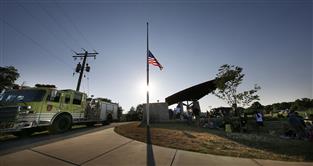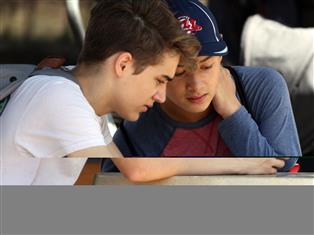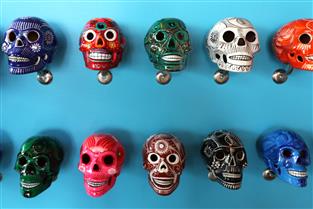Ground-shattering research is always in the works inside the Accelerator Building at the University of Wisconsin-Milwaukee's Innovation Campus, on Discovery Parkway in Wauwatosa.
Among the vast assortment of research topics housed inside the building is scoliosis, the Ebola virus and the sturdiness of protective military equipment.
The Accelerator Building, funded in part by a $5.4 million federal grant, opened in spring 2014 and enables students to work alongside industry professionals, which was the No. 1 goal from the start, said David Gilbert, executive director of the University of Wisconsin-Milwaukee's Innovation Campus.
One example of that side-by-side environment is the bioengineering, imaging and testing lab. One day in mid-May, two UWM students worked to piece together a 3D printer, which synthesizes a three-dimensional object. In that process, successive layers of material are formed under computer control to create the object.
The students twisted knobs and examined parts against a backdrop of water tanks that housed tiny fish. Through his research, a local scientist found a small fish with scoliosis and reproduced it to study the curvature of the spine and how to resolve it. A three-dimensional print of a fish with scoliosis sat nearby.
The lab is expansive and includes a cooler of cadavers, offices and several working stations.
"This place is a castle," said Naira Campbell-Kyureghyan, who has worked in research labs all over the country, about the UWM Innovation Accelerator. In addition to teaching at UWM, Campbell-Kyureghyan serves as director of the bioengineering, imaging and testing lab. Access to and partnerships with nearby medical facilities such as the Milwaukee County Medical Complex, Children's Hospital, and the Medical College of Wisconsin is what makes the building truly marvelous, she said.
"There are no limits," she said.
A number of UWM researchers work with corporate partners to provide industry services, create jobs and provide educational opportunities to students. The building's layout is developed to promote synergies between tenants, allowing processes to quickly run from the design phase, to prototyping and eventually testing.
On the building's first floor is a prototyping and fabrication lab, which works to support research in the building, said lead mechanical engineer with Brooks Stevens Design Kyle Jansson. The industrial design firm operates an office in the Accelerator building.
That particular lab, which houses a number of industrial machining tools like a large 3D printer, a CNC router, a welding shop and a plasma cutter, would not be used to mass produce materials or products. Instead, it's used to create prototypes, he said.
"If you can dream it, we can create it," he said.
One use of the lab's large 3D printer was to meet the request of a surgeon, who sought a solution to a patient with an askew set of hips. Several copies of the patient's hip bones were printed and the surgeon was able to test different medical procedures on the copies to determine the best course of action on the operating table.
"This is a joy to have at our fingertips," said Jansson of the vast array of equipment.
In another laboratory, researcher Yenta Chen worked intensely in the building's Bio-Sensor Fabrication Laboratory.
That lab is home to several different projects at any given time, said Gilbert, one lately focused on developing a new, innovative way to detect the Ebola virus through a hand-held saliva test. Another ongoing project works to create a sensor that can detect lead in water, Gilbert said.
On the building's second floor is a suite occupied by Concordia University. The space houses tools to manufacture pharmaceutical compounds and a cleanroom, which is a space with a low level of environmental pollutants such as dust, airborne microbes, aerosol particles, and chemical vapors typically used for manufacturing pharmaceuticals or scientific research. A cleanroom is also found in the biosensor fabrication lab.
Other collaborators found at the Accelerator Building include Bridge to Cures Inc. and TAI Diagnostics.
Another notable asset of the building is the mobility lab, which works to advance quantitative rehabilitation research for improving health and function of persons with disabilities. In the lab, stick-on sensors are placed on patients to study movements and exercises. The sensors, identified through infrared cameras, relay information to the researchers, allowing them to focus on specific areas or movements of interest.
The makeup of the Accelerator Building is likely to morph in the coming years as more collaborators, entrepreneurs and researchers are brought on. A Marriott extended-stay hotel will be built on a nearby plot of land, which will better help researchers to take advantage of the building's vast assortment of resources, Gilbert said.

E-mail Newsletter
Your link to the biggest stories in the suburbs delivered Thursday mornings.
Enter your e-mail address above and click "Sign Up Now!" to begin receiving your e-mail newsletter
Get the Newsletter!
Archives
- Hidden Tosa: Inside Annunciation Greek Orthodox Church
- Hidden Tosa: Unearthing the Wauwatosa Cemetery: a look at the chapel and grave sites
- Hidden Tosa: In the tunnels beneath Christ King Parish
- Hidden Tosa: Between Lake Michigan and your faucet, where water flows
- Hidden Tosa: The sordid life story of garbage
- Hidden Tosa: Wauwatosa's Hoyt Park holds generations of memories
- Hidden Tosa: Smaller three Eschweiler buildings hold echoes of the past
- Hidden Tosa: Now on chopping block, Milwaukee County's business incubator was once tuberculosis hospital
- Hidden Tosa: See What Lurks Beneath the City Streets
















We welcome reader discussion but strive to keep things civil. Please see our discussion guidelines and terms of use for more information. If you see a comment that violates our guidelines, please flag it for review. If you have any other issues with our commenting system, please let us know.